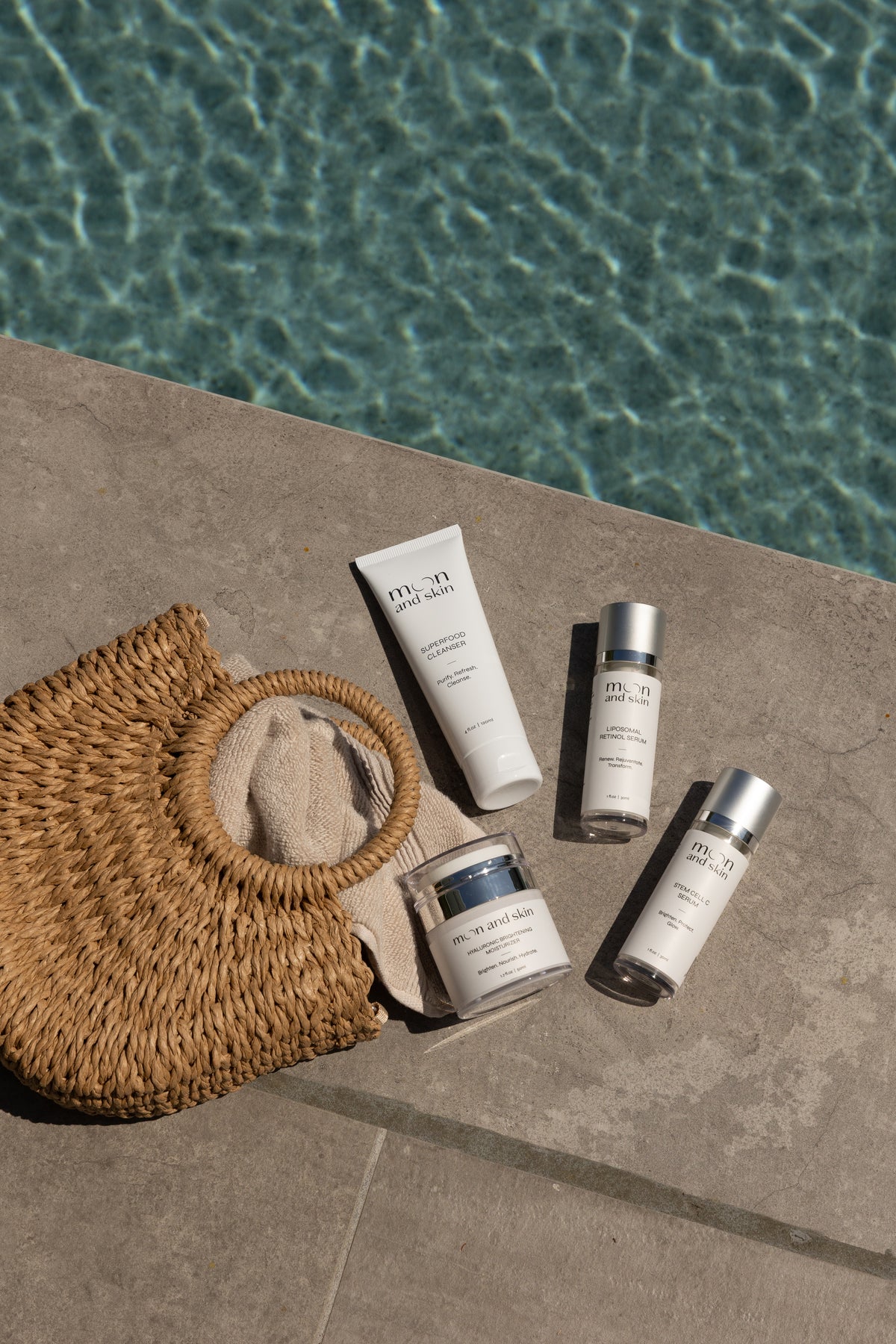Table of Contents
Introduction
Have you ever felt overwhelmed by the vast array of skincare products available today? If so, you're not alone. In fact, research shows that 78% of consumers find it challenging to navigate the skincare aisle, particularly when it comes to understanding the ingredients. Among these, acids are often touted as the game-changers in achieving radiant, clear skin. But how do we effectively incorporate these acids into our routines without causing irritation or confusion?
At Moon and Skin, we understand that navigating the world of skincare acids can be confusing. With our mission of providing clean, thoughtful skincare for every phase of life, we are here to demystify the process of layering skincare acids for maximum efficacy. This blog post will cover the different types of acids, how to layer them correctly, and the best practices to ensure your skin reaps the full benefits.
Let’s explore how to layer skincare acids to achieve that coveted glow while maintaining skin health.
Understanding Skincare Acids
Before diving into the layering process, it’s essential to understand the various types of skincare acids and their unique properties. Skincare acids are primarily categorized into two groups: Alpha Hydroxy Acids (AHAs) and Beta Hydroxy Acids (BHAs).
Alpha Hydroxy Acids (AHAs)
AHAs are water-soluble acids derived from fruits and are primarily used for surface exfoliation. They work by loosening the bonds between dead skin cells, allowing them to be shed more easily. This leads to improved skin texture and brightness. Common AHAs include:
- Glycolic Acid: Known for its tiny molecules that penetrate deeply into the skin, promoting collagen production and reducing the appearance of fine lines and wrinkles.
- Lactic Acid: Gentler than glycolic acid, making it suitable for sensitive skin. It also hydrates the skin while exfoliating, promoting an even skin tone.
- Mandelic Acid: With larger molecules, mandelic acid is milder and ideal for brightening dull skin and targeting hyperpigmentation.
Beta Hydroxy Acids (BHAs)
BHAs are oil-soluble acids that penetrate deeper into the pores, making them effective for oily and acne-prone skin. The most well-known BHA is:
- Salicylic Acid: This potent ingredient helps to unclog pores, reduce inflammation, and combat acne by exfoliating both the surface and inside the pores.
Other Notable Acids
While AHAs and BHAs are the most common, there are other acids worth mentioning:
- Hyaluronic Acid: Not an exfoliant, but a powerful humectant that draws moisture into the skin, making it an excellent companion to AHAs and BHAs.
- Azelaic Acid: Known for its antibacterial properties, it helps to reduce redness and is effective for treating acne and rosacea.
Understanding these acids is crucial for creating a balanced skincare routine that addresses your unique skin concerns.
The Importance of Layering Acids Correctly
Layering acids effectively can yield remarkable results, but it’s vital to understand the order of application. Using products in the wrong sequence can lead to irritation or diminish their effectiveness. The general rule of thumb is to layer from thinnest to thickest, starting with the lowest pH products.
The pH Factor
Skincare products have varying pH levels, which influence their effectiveness. AHAs typically have a pH between 3.0 and 4.0, while BHAs are slightly lower, around 3.0 to 3.5. When layering, always apply products from lowest pH to highest pH to maximize their efficacy.
By following this principle, you ensure that the products can work optimally without interfering with each other.
How to Layer Skincare Acids: A Step-by-Step Approach
Now that we have a foundational understanding of skincare acids and their pH levels, let’s break down how to layer them effectively.
Step 1: Cleanse Your Skin
Before applying any acids, it’s essential to start with clean skin. We recommend using our Superfood Cleanser to remove impurities without stripping your skin of its natural oils. This gentle yet effective cleanser prepares your skin for the upcoming treatments.
Step 2: Apply Your Exfoliating Acid
Once your skin is clean, it’s time to apply your exfoliating acid. If you’re using both AHA and BHA, begin with the BHA (like salicylic acid) as it penetrates deeper.
- How to Apply: Use a few drops of your chosen acid on a cotton pad and gently sweep it over your face. Alternatively, you can use your fingertips to apply the product directly onto your skin.
Step 3: Wait for Absorption
Allow the acid to absorb for a few minutes before moving on to the next step. This waiting period ensures that the active ingredients penetrate the skin effectively without being diluted or neutralized by subsequent products.
Step 4: Apply Your AHA
After the BHA has fully absorbed, apply your AHA. This could be glycolic or lactic acid, depending on your skin’s specific needs.
- How to Apply: Similar to the BHA, you can use a cotton pad or your fingers. Focus on areas that may need extra exfoliation, such as the forehead and cheeks.
Step 5: Hydrate with Hyaluronic Acid
Following the exfoliation step, it’s crucial to hydrate your skin. Apply a hydrating serum containing hyaluronic acid to replenish moisture and create a barrier.
- Why It’s Important: Hyaluronic acid draws moisture into the skin and helps mitigate any potential irritation from the acids.
Step 6: Moisturize
Seal in hydration with a moisturizer. Our Hyaluronic Brightening Moisturizer not only hydrates but also brightens your skin, making it an excellent choice following acid application.
Step 7: Apply Sunscreen
If you’re doing this routine in the morning, never forget to apply sunscreen. Acids can increase your skin's sensitivity to the sun, making it essential to protect your skin from UV damage.
Common Combinations and What to Avoid
While layering acids can be beneficial, there are specific combinations that should be avoided to prevent irritation:
1. AHA + BHA
Using AHAs and BHAs together can be effective, but it’s crucial to monitor your skin’s reaction. If you experience irritation, consider alternating their use on different days.
2. AHA + Vitamin C
Vitamin C is a powerful antioxidant, but it has a low pH similar to AHAs. Using them together can lead to irritation and negate the effects of vitamin C. Instead, use vitamin C in the morning and AHAs in the evening.
3. BHA + Retinol
Both BHAs and retinol can be potent on their own. Using them together may overwhelm sensitive skin. Instead, consider using them on alternate nights.
4. Niacinamide + Acids
Niacinamide can help counteract irritation from acids, but applying them simultaneously may cause redness. Allow 30 minutes between applying acids and niacinamide for optimal results.
Key Takeaways
- Always cleanse your skin before applying any acids.
- Layer from thinnest to thickest, starting with the lowest pH.
- Incorporate hyaluronic acid after exfoliating acids for hydration.
- Be cautious with combinations of acids, retinol, and vitamin C to avoid irritation.
Conclusion
Layering skincare acids can transform your skincare routine and help you achieve radiant, clear skin. By understanding the different types of acids, their pH levels, and the correct order to apply them, you can create a tailored regimen that addresses your unique skin concerns.
At Moon and Skin, we are committed to providing clean, thoughtful skincare solutions for every phase of life. Our Bundle & Save collection offers an excellent way to build a complete skincare routine, featuring our core products like the Stem Cell C Serum, Liposomal Retinol Serum, and Hyaluronic Brightening Moisturizer.
Together, we can embark on a journey to healthier, more vibrant skin. Are you ready to elevate your skincare routine?
FAQ
1. Can I use multiple acids in one routine? Yes, but be cautious. Start with a BHA, followed by an AHA, and monitor your skin's reaction.
2. How often should I use acids? Begin with 2-3 times a week, then adjust based on your skin's tolerance.
3. Can I use acids in the morning? Yes, but always follow with sunscreen to protect your skin.
4. What should I do if my skin becomes irritated? Reduce the frequency of use and consider using gentler formulations.
5. Is it necessary to use a moisturizer after applying acids? Absolutely. Moisturizers help to replenish hydration and protect your skin barrier after exfoliation.







